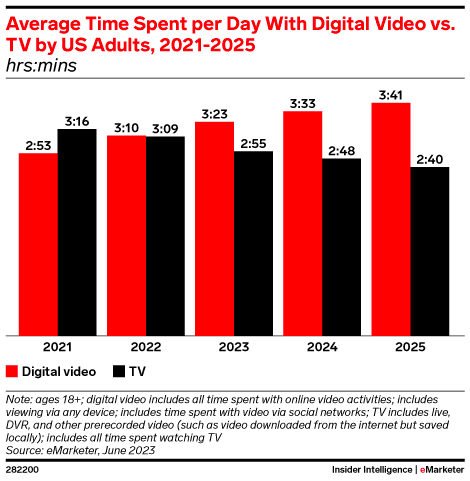Experiences refined for people
Experiences refined for people
We’ve all heard the drumbeat: cord-cutting is accelerating, linear TV viewers are migrating to streaming platforms, and younger audiences have completely detached from traditional television.
Linear TV is still an effective mass-reach strategy for 49.6% of the US population, but its role and impact in the advertising ecosystem are undoubtedly evolving.
Read more about what linear TV is, its benefits, and how it’s changing, especially with CTV advertising taking off.
Linear TV advertising is the traditional method of broadcasting television advertisements aired during commercial breaks within scheduled programming on cable or satellite TV channels.
The term “linear TV” comes from content delivery’s sequential, or “linear,” nature.
In contrast to streaming services, where viewers choose content at their leisure, linear formats schedule and broadcast programs in a set order, requiring viewers to tune in at specific times.
Linear TV delivers content at a scheduled time, while non-linear TV removes this limitation. Viewers can decide when and what to watch.
Streaming networks like Netflix, Hulu, and others are non-linear TV services, as viewers can choose where and when to watch.
Linear TV advertising follows a traditional approach with scheduled ad slots on cable or satellite channels, targeting a broad audience. OTT and CTV advertising use internet-based platforms for precise audience engagement and targeting.
📚 Related article: OTT vs CTV: Read more about the differences between linear TV vs CTT and OTT.
Linear TV advertising reaches a wide audience with the same ad across all screens, relying on broad demographic targeting based on the program’s viewership. Addressable TV advertising delivers different ads to different households watching the same program.
Linear TV advertising works by placing commercials during breaks in TV programming.
The process typically works like this:
Once an ad plays on linear TV, advertisers may adjust their strategies based on performance data, viewer trends, and changes in programming schedules.
Linear TV benefits include:
Linear TV still captures a large audience, particularly among older demographics. Linear TV ad impressions reached more viewers aged 55 and older than younger audiences. Viewers aged 65 and older dedicate an average of 4 hours and 58 minutes daily to watching linear TV, in stark contrast to the 25-34 age group, watching only 1 hour and 12 minutes daily.
While linear TV doesn’t offer the same level of sophisticated audience targeting as CTV/OTT platforms, it does provide the ability to target audiences based on specific channels or broadcast times. This is most successful if you know that your ideal customers tend to watch a particular show at a specific time.
Advertising during live events, like sports or award shows, can reach captive, engaged audiences. Despite streaming services vying for a piece of the live sports market, technical challenges like increased latency mean that linear TV is still the go-to for broadcasting these events.
Is Linear TV advertising still relevant?
“As the media landscape evolves rapidly, linear TV will maintain its relevance and influence in 2024. While it is a tried & true tactic for awareness-driven campaigns, due to the broad reach of a diverse demographic, the 2024 Election and the Olympics will further boost ad spending for this year, keeping linear in the advertising game.”

Linear TV still functions as an effective mass reach strategy, but there are challenges that advertisers are forced to address along with limitations in the buying model.
Linear TV’s strength in mass reach often becomes a double-edged sword. While advantageous for brand visibility, the broad reach leads to media waste, where a significant portion of the advertising budget is spent on reaching viewers outside the brand’s target audience.
Advertising efforts and expenditures may not contribute effectively to the brand’s specific marketing objectives.
Today, TV content is not just confined to the traditional television set. Viewers access their favorite shows and movies across various devices like smartphones, tablets, laptops, and streaming devices like Chromecast.
Audience fragmentation means linear TV advertisers have difficulty capturing a significant, unified viewership.
In the era of linear TV, ratings have been the cornerstone of measuring a show’s popularity and, by extension, the potential reach of advertisements. However, as media consumption habits evolve, these ratings lose their once-critical relevance.
Each upfront season, which sets the stage for advertising contracts, highlights this shift, with ratings no longer providing the comprehensive insight they once did.
Nielsen traditionally measures linear TV viewership by distributing devices to around 100,000 viewers in 41,000 households and then extrapolates this data to estimate nationwide viewership percentages.
Unlike linear, digital platforms offer many actionable insights, allowing advertisers to track user engagement, click-through rates, conversions, and other metrics in real-time.
As viewers shift to Connected TV, linear TV viewership is declining. Linear TV decreased from 51.4% in June 2023 and a more substantial year-over-year drop from 56.0% in July 2022.

Projections suggest that by 2025, US adults will spend over an hour more per day on digital video compared to traditional TV.
Connected TV (CTV) is a viable solution to address linear TV’s shortcomings, offering a blend of high viewer engagement and sophisticated targeting capabilities.
Being mostly unskippable, CTV ads boast video completion rates often exceeding 90%. The advertiser’s entire message is more likely to be seen and heard.
CTV goes beyond the broad demographic targeting of traditional TV, utilizing detailed demographic, geographic, and behavioral data.
CTV addresses linear TV’s fragmentation problem by providing a consolidated platform for inventory across a wide range of content categories. By partnering with companies like KORTX, advertisers can access multiple inventory sources through a single platform.
Advertisers can access impression-level reporting, monitor video completion rates, and check viewability metrics. This allows for real-time, mid-campaign adjustments to optimize performance.
📚 Related article: CTV Advertising: What It Is + How It Works: Explore how CTV works to complement your linear TV strategy.
How does CTV advertising complement or provide a solution to linear TV’s shortcomings?
“CTV’s ability to incorporate precise audience targeting and trackable actions make it the perfect complement or substitute for linear TV. If a brand wants extensive reach and awareness, linear can be a great tactic. Pair it with CTV, and you have a plan that reaches people across devices and pushes users further down the marketing funnel. CTV is also a great alternative to linear if a brand seeks a highly targeted and cost-effective tactic that still reaches users on well-known, quality publishers.”

While the rise of cord-cutting and the migration of audiences to streaming platforms have posed challenges to linear TV, it can serve as a potent medium for mass-reach advertising, especially when integrated with modern approaches like CTV, to reach and engage diverse audiences.
With our expertise and advanced tools, we’ll help you navigate the complexities of TV ad placements, ensuring your message reaches the right audience at the right time.
Kate Meda is a Copywriter at KORTX. She enjoys omitting needless words and making things sound good.
From us to your inbox weekly.